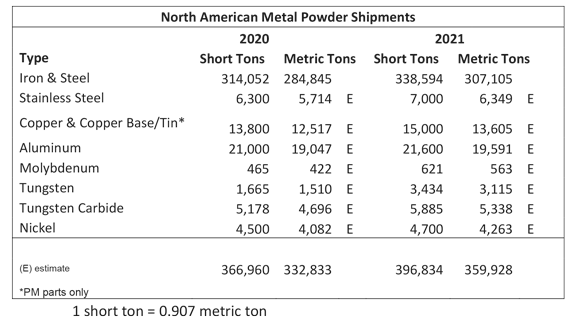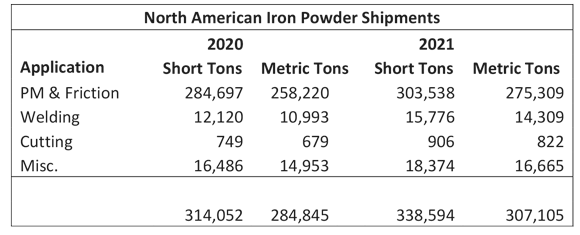PowderMet2022: State of the North American PM industry
June 21, 2022

The PowderMet2022: International Conference on Powder Metallurgy & Particulate Materials, and the co-located AMPM2022: Additive Manufacturing with Powder Metallurgy Conference, was held in Portland, Oregon, USA, from June 12–15, 2022. Organised by the Metal Powder Industries Federation (MPIF), the event included three days of presentations accompanied by an exhibition and a range of social and networking events.
The Opening General Session included a presentation by MPIF President Rodney Brennen, who gave delegates a detailed overview of the state of the North American Powder Metallurgy industry.
“The North American Powder Metallurgy industry has not been immune from the unprecedented challenges facing the global supply‐chain. We continue to feel the negative effects of the COVID‐19 pandemic,” began Brennen.
The semiconductor microchip processor shortages also had a major impact on the PM sector, and continues to cause delays in automotive production. “Most automotive companies, whose vehicles use an estimated 20‐100 processors each, depending on the vehicle’s features, agree that recovery will begin in the second half of 2022, but a normal supply won’t be met until well into 2023. Volkswagen doesn’t expect demands to be met until 2024,” Brennen explained.
Further global events negatively impacting the PM industry were highlighted by Brennen, who then went on to say that many of these major disruptions should be viewed as opportunities. “They have forced companies to work smarter, be more efficient, and innovative. New production output levels are being achieved thanks to changes and innovations made because of the pandemic. Many companies report reductions in energy consumption, furnace atmosphere gasses, scrap, and waste that is sent to landfills as a direct result of operating more efficiently.”
“Some companies have replaced older equipment with the latest computer controlled Industry 4.0 technology. This ‘Internet of Things’ approach allows equipment to ‘talk’ to each other and learn the best parameters for the process. Automation within the industry continues to grow as a solution to the overall shortage of workers. From pick‐and‐place robots at the compacting presses and furnaces, to 100% vision system inspections, automation will continue to increase.”
“The PM industry is alive and well, landing back on its feet, and on its way to recovery,” noted Brennen.
North American metal powder shipments

The MPIF reported that total estimated 2021 North American metal powder shipments increased by 8.1% to 359,928 mt.
Total iron powder shipments increased 7.8% to 307,105 mt. Stainless steel, copper, nickel, and aluminium powder shipments all increased by an estimated 3% to 11%. Estimated shipments for 2021 include stainless steel powder, 6,349 mt; copper and copper base powder, 13,605 mt; nickel powder, 4,263 mt; and aluminium powder 19,591 mt.
Refractory powder had a strong showing in 2021 after decreased shipments over the past few years. Molybdenum shipments increased an estimated 33.5% to 563 mt. Tungsten powder shipments increased by an estimated 106% to 3,115 mt, and tungsten carbide powder shipments increased an estimated 13.7% to 5,338 mt.
Historically, iron powder shipments have been the best barometer of the health of the PM industry, explained the MPIF, but there will likely be a correction as the auto industry downsizes engines from 8‐cylinders to 4‐cylinders, and the acceptance of hybrid (HV) and electric (EV) vehicles.

PM and friction‐grade iron powder shipments were up 6.6% to 275,309 mt. Welding applications increased by 30.2% to 14,309 mt. Cutting, scarfing, and lancing applications increased by 21% to 822 mt. Miscellaneous uses increased 11.5% to 16,665 mt.
Metal powder activities
“Powder producers continue to respond to the needs of the industry by developing new and improved materials and additives for conventional press and sinter, MIM, and metal AM. Over the past two years, dry lubricants have been in limited supply and high‐demand, forcing companies to seek alternatives. The demand to improve ‘value‐added’ machining has resulted in new high green strength materials that are suitable for green machining,” continued Brennen.
With the electrification of the automobile increasing, soft magnetic and soft magnetic composites are being researched by all major iron powder producers. “Most have ongoing collaborative efforts with their customers and academia to identify higher permeability, lower core loss, and increased part strength materials and processes. The MPIF Standards Committee is keeping a keen eye on this development.”
MIM and AM powder producers were reported to be seeing strong demands for materials. Generally, the materials of choice are stainless steels and low alloy steels, but there is considerable developmental work being performed on aluminium, titanium, and an array of other metal powders and alloys, added Brennen. Total 2021 North American MIM and AM powder shipments increased by an estimated 5‐10% to 3,934,767‐4,202,178 kg. Of this amount, an estimated 360,000 kg is dedicated to AM.
“Improving powder quality will benefit both MIM and AM. A narrower particle size distribution range, greater sphericity, fewer satellites, and less internal porosity will improve throughput, mechanical properties, and overall process consistency. Typically, these powders are manufactured by gas atomisation, but capacity has been added recently for plasma atomisation and research continues to develop water‐atomised low‐alloy materials for MIM and AM.”
Conventional Press & Sinter
The MPIF stated that PM parts makers report a continued surge from the industrial sector, requiring value‐added, near‐net‐shape parts that have cost‐effective lean‐alloy materials, with high material utilisation rates. Most have realised increased backlogs, month after month. Disrupted supply chains have resulted in the re‐shoring of some PM parts, but not to the extent that most had hoped.
“The general feeling from the conventional press & sinter parts makers is high single‐digit to low double digit‐growth for non‐automotive applications. The current outlook for automotive applications is not as good due to supply chain disruptions,” added Brennen.
The MPIF estimates over 70% of the iron powder shipped is used for parts in internal combustion engine (ICE) passenger vehicles. Unfortunately, it appears HVs have limited use, or are not using, powder forged connecting rods and PM main bearing caps. And obviously, EVs don’t have connecting rods and main bearing caps.
“To put things into perspective, there is roughly 9 kg of iron powder used for powder forged connecting rods and main bearing caps in an 8‐cylinder engine. So, as HVs and EVs gain greater acceptance, we can expect iron powder shipments to decline until other applications pick up the volume.”
”Each year, we estimate the amount of PM in a North American passenger vehicle. In 2021, there were roughly 15 million vehicles sold, about 500 thousand more than 2020, but 2 million less than pre‐COVID 2019. The semiconductor shortages had a devastating effect on vehicle sales as car lots were empty.”
The automotive manufacturers reportedly diverted the semiconductors to produce the higher‐margin large pick‐up trucks and SUVs over the lower‐margin sedans. “This was great news for the PM industry as the large passenger vehicles consume an average 27.2 kg per vehicle, followed by the midsize crossover vehicles at 18.1 kg and the sedans at 9.1 kg. Our best estimate for EVs, less the battery, ranges from 1.8‐3.6 kg of PM. Taking everything into consideration, the estimated average weight in a 2021 North American passenger vehicle remained at 16.8 kg,” explained Brennen.
As the semiconductor shortage weans, and HVs and EVs gain greater acceptance, the PM weight in passenger vehicles will likely decrease 2‐3% annually without new applications, it was stated. However, there are opportunities to introduce the use of powder forged connecting rods and PM main bearing caps in HVs, and new applications in EVs.
“But we can’t depend solely on the automotive industry. In 2001, MPIF launched the PM Industry Vision and Technology Roadmap. One of the six priorities identified was ‘Focus on emerging product needs’ that noted: ‘Reliance on the internal combustion engine is decreasing and PM producers must develop materials and systems required for emerging fuel cell and hybrid‐electric vehicle technology.’ That was over 20 years ago, and we are still talking about it today…,” Brennen said.
Refractory metals and hard materials
It was reported that in 2021, the tungsten market significantly increased on an overall basis with continued strong growth in the semiconductor market, driving demand for high purity tungsten powder due to the demands for newer generation chips used in 5G, personal computers, super computers, smartphones, electric vehicles, smart TVs, and other ‘Internet of Things’ devices. Tungsten powder for the defence industry also remained strong. Another positive trend that boosted tungsten powder shipments was North American customers buying from domestic producers instead of Asian producers whose supply chains represented significant delays and risk.
The tungsten carbide market moderately improved but was still impacted by a reduced North American oil and gas exploration and a depressed coal mining market. There was a moderate increase in demand for tungsten carbide for cutting tools and wear parts due to a resurgence in manufacturing, but the demand was impacted by shortages in raw materials and labor, as well as transportation issues and rising costs.
North American oil and gas rig counts finished the year up 65% over 2020, which had the lowest levels since 1949. At the end of 2021, the North American rig count was 676 compared to a twenty-year average of 1,514 and the most recent five‐year average of 842. In 2021, coal production in the US was up 8% over 2020 according to the U.S. Energy Information Agency, but 2020 was one of the worse years on record. Reduced automotive production resulted in inconsistent demand for cutting tools. Other manufacturing sectors picked up in 2021, but again shipping backlogs and COVID‐19 lockdowns in China disrupted raw materials.
“Longer transportation timeframes have had a significant impact on international shipments of tungsten concentrates and other raw materials. The uncertainty has led manufacturers to increase inventories to avoid the possibility of running low on raw materials. For the most part, increased prices did not have a discernible impact on demand from many industrial manufacturers in the North American market,” added Brennen.
North American molybdenum powder demand was estimated to be up by 33%. Molybdenum is used in PM applications for such industries as aerospace, automotive, medical, defence, industrial, and electronics. Demand for these applications surged in 2021 increasing the need for molybdenum powders for the diverse PM parts that service these markets, reported the MPIF.
Powder Metallurgy outlook
In his concluding remarks, Brennen stated “I believe the industry will be able to adapt and overcome, but we will need the mindset and resources to adjust to the changing environment. As an industry, we need to showcase our strengths and work together to advance the technology. We have a lot of advantages over other metal‐forming technologies.”
“Many companies in our industry have aggressive programs to become carbon‐neutral, sooner than later. Last year we learned about iron powder being used as an energy source, combusting it with hot gases to drive an engine, producing sustainable electricity. We also learned about a sustainable energy‐focused infrastructure for storing zero‐emission metal‐hydride energy. This innovative, safe, and renewable energy storage solution utilises high‐density PM pellets.”
“Other non‐traditional applications for metal powers include water purification, thermal management, and solar energy. And how about the research to remove oxygen from moon dust? The process byproduct is metal powder that one day could be used to make structures on the moon.”
“These are just a few examples of creative uses and new opportunities for metal powders. We need to set our sights long‐term, not just on meeting our monthly goals. We need to invest in R&D to create new applications and uses for metal powders and PM parts. And we need to work together for a common goal.”
“We have a lot to look forward to as we advance the PM technology,” Brennen told the audience as he concluded his PowderMet2022 presentation.














